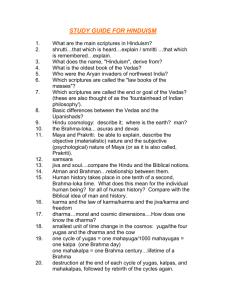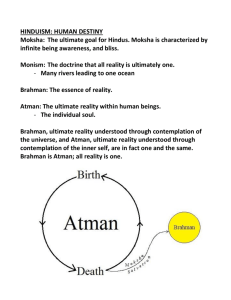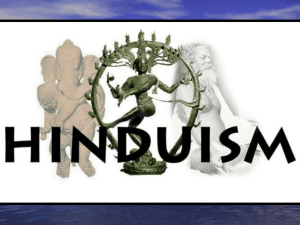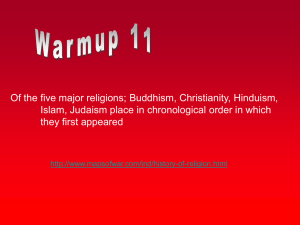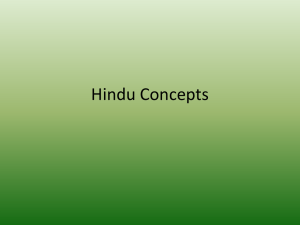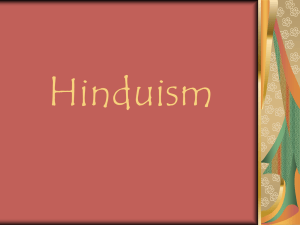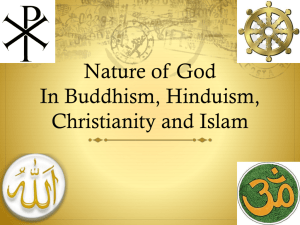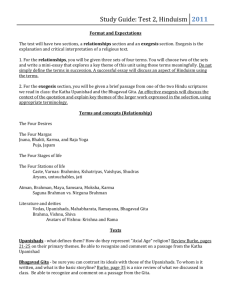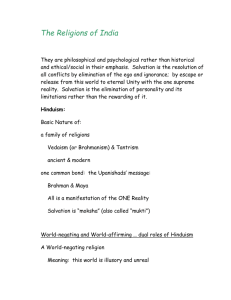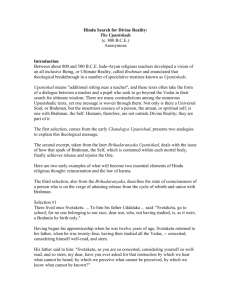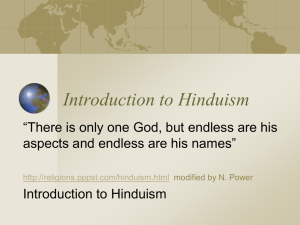Powerpoint - John Provost
advertisement
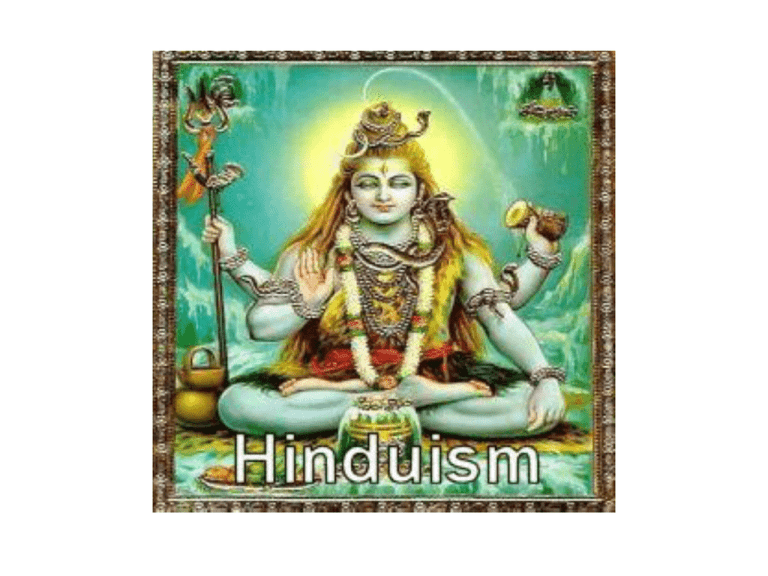
Mohandas Gandhi (1869-1948) The Culture of India • The culture and religion of India is neither monolithic nor divided into watertight compartments. Like America, it is a mix of many colors. Suffering from Ignorance • Hindus teach that we all suffer from ignorance about our true identity. What we need is selfknowledge. The various paths we will study lead to this knowledge. Shiva: Absolute Cosmic Being • Shiva is the absolute cosmic Being, sheer life force, and Shakti is the absolute power of the phenomenal universe, creative and destructive. The Wet • For Hindus, the “wetness” of water is a way of understanding how God, “the wet,” is present in all of material reality, “the water.” Karma • Karma also refers to that chain of cause of effect set in motion by one’s deeds in the world. Moksha • This is moksha, “leaping out,” finding liberation. It is the final quest, after all other quests have run out. Four Stages of Life • The four ashramas are also known as the “Four Stages of Life”: student, householder, hermit or forest dweller, and renunciant. Brahman • The realization comes through that there is only OneBrahman, Universal Being. God beyond all personalities and that “Thou art that”. The Vedas • The earliest religious texts that we have are the Vedas. The Aryans in India are chiefly known as the people of the Vedas, the fundamental official scriptures of Hinduism. The Upanishads • Our understanding of Hinduism comes from the commentaries on the Vedas, the most famous of which are called the Upanishads. In Brahman as Brahman • This means that creation isn’t outside of Brahman. Brahman isn’t off in some heaven somewhere. Rather existence, nature, & our very lives exist in Brahman as Brahman. Atman is Brahman • The great inner knowledge to which the wise ones of the Upanishads came is “Atman is Brahman.” Atman is the innermost self, the “soul”. Playing Hide-and-Seek • Brahman plays hideand-seek with itself in the world, dwelling in the myriad things while elusive to human thought and dream. One Mind • But the difference is that in the Upanishadic vision there are not many actors but one actor - the One Mind who is playing all the parts and is also the prompter. Prajna • Prajna means that sharp, intuitive insight that simply knows, without the confusion of words or ideas from the world of the many. The Laws of Manu • The Laws of Manu allow one to do both by saying that there are different things required at different points in your life. Samadhi • The last 3 steps are interior: dharmana, concentration; dhyana, meditation; and samadhi, the absolutely equalized consciousness of perfect freedom. Sri Aurobindo 1872-1950 • Integral Yoga is the path of combining all four yogas the way an athlete might use cross training to improve his/her health. The Adorable One • The English title might be translated as “Song of the Blessed One” or “Song of the Adorable One.” The adorable one is Lord Krishna, who is God in human form. Fulfilling Our Purpose • Krishna teaches that it’s not what we do but how we do it and in what spirit we do it. We must fulfill our purpose to the best of our ability. The Dance of the Cosmos • Then, with one’s feelings not getting in the way, one’s actions are a part of the great dance of the cosmos, of the life of the whole social & natural organism, & are as quiet and far-reaching as meditation. Hindu Philosophy • The tradition of Hindu philosophy that has generally been most prestigious in India & is best known outside that country is Vedanta. The word literally means “the end, that is, culmination) of the Vedas.” Tantrism • Its basic premise is that if nothing is separate from God then nothing is unholy. Therefore, all things can lead one to God because God is in everything. Bhakti Blossom • Through the love of gods, whom one can visualize & adore, but who are themselves not separate from the absolute, one shares their nonseparateness, for one becomes what one loves. Many Paths to God • Ramakrishna taught that all religions are of the same essence and are paths to Godrealization. Suffering and Karma • Gandhi said that if someone was suffering it might very well be because of his/her karma, but nevertheless, it was our karma to help him/her. Balance • One thing Hindu women have going for them is that Hindu philosophy is very clear that both female and male energies are needed, & that it is a problem when they aren’t balanced. Intolerance • Wherever fundamentalism rears its head, you tend to see intolerance for those with different beliefs. Swami Vivekananda in America • The World Parliament of Religions at the Chicago World’s Fair in 1893 marked the introduction of Hinduism to America. A Tolerant Philosophy • In general, it’s a tolerant philosophy. For example, Hinduism doesn’t expect all Hindus to follow the same path or lifestyle. Advaita Vedanta • Its most influential form is known as Advaita Vedanta, which teaches that there is only one ultimate reality, Brahman, & we’re united with that source as our own very being.
